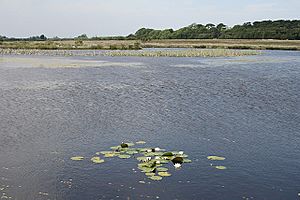Cefn Bryn facts for kids
Cefn Bryn is a very old ridge in Great Britain. It is a long, narrow hill made of Old Red Sandstone. This ridge is about 5 miles (8 km) long and is found in south Wales. It sits right in the middle of the Gower Peninsula, which is part of the City and County of Swansea.
Local people often call Cefn Bryn the "backbone of Gower." This is because it stands out from the flatter limestone land around it. The highest part of the ridge is 188 meters (617 feet) high. This makes it the second highest point in the Gower Peninsula. From the top, you can see amazing views of the land and sea all around. The large areas of grass around the ridge are called Cefn Bryn Common.
A road runs along the top of Cefn Bryn, with grassy common land on both sides. This road goes from Cilibion to Reynoldston. In the past, it was known as the Old Coal Road or Red Road. As you travel along the road, you might see sheep, wild ponies, and cows wandering freely. The road has large bumps and dips. These are formed by natural holes in the surrounding limestone, called swallets and sinkholes. The highest point of the road crosses right over the top of the ridge.
Arthur's Stone: An Ancient Burial Site
Just north of the highest point of Cefn Bryn, you will find an ancient burial site called "Arthur's Stone." This site dates back to the neolithic period, which was a very long time ago. Its Welsh name is Maen Ceti.
The name "Arthur's Stone" comes from an old story. The legend says that the famous ancient British King Arthur threw a huge stone all the way from Llanelli. It supposedly landed right on this spot!
Experts believe that Cefn Bryn was a very important place for ceremonies and rituals during the Bronze Age. This was a time when people used bronze tools. More than sixty cairns have been found hidden under the bracken plants on the hill. Cairns are piles of stones. Most of these were probably just stones cleared by farmers long ago. However, three large cairns just north-west of Arthur's Stone have been dug up by archaeologists. These excavations show that they were indeed ancient burial sites. The biggest one is called Great Cairn. It is a round pile of stones built over a central grave.
Broad Pool: A Special Nature Spot
At the bottom of the eastern side of Cefn Bryn, there is a small fresh water pond called Broad Pool. We know this pool has been there since at least 1645. It has dried out and been dug deeper twice over the years.
Today, Broad Pool is a protected nature reserve. It sits in a shallow dip on the limestone land below Cefn Bryn. The area includes an acidic pond, heathland, and a bog. This makes it a very important home for many different living things. You can find special aquatic plants, amphibians like frogs and newts, and many types of dragonflies. This includes the rare Southern Damselfly. It is also a great place for wetland birds.
Cefn Bryn in Art
Cefn Bryn has even been featured in art! A landscape painting of Cefn Bryn, seen from Pennard Castle, was created by the Neo-impressionist painter Lucien Pissarro. You can see this painting in the Glynn Vivian Art Gallery in Swansea.





